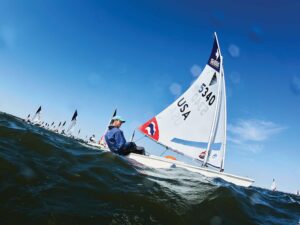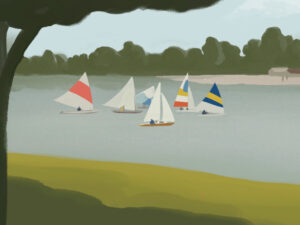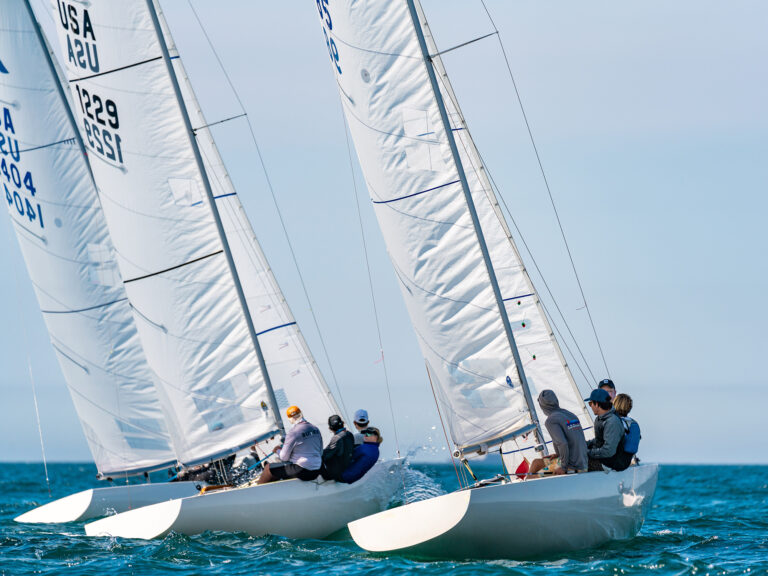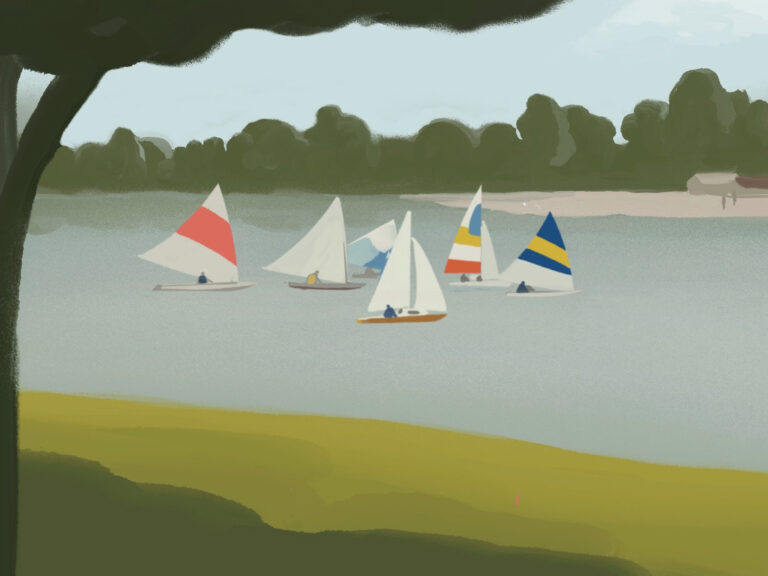I didnt travel to the 1992 spring collegiate nationals at the College of Charleston as part of a team. I went as part of an army, the Dartmouth College Lite Brigade, complete with spirit squad, chauffeurs, a few engineers, and a social committee. I was the hurricane insurance. Luckily my coaches failed to realize the hurricane season is in the fall
Certified Force-5 rail steak, I spent most of the time working on my tan-a delicate task after a long winter a few degrees south of the Arctic Circle. We won enough boat races to take home a pair of national titles and barroom bragging rights-I figured more prominently in bringing back the latter. I got one hell of a sunburn. I sailed in one race. I had the time of my life.
It was a little disconcerting to my parents that my choice of college was based in large part on whether it had a decent sailing program. After all, the highlight of my junior sailing career had been a Narragansett Bay Yachting Association 14-and-under team race championship. I had never even seen a Flying Junior until I journeyed down to the Dartmouth Corinthian YC on Mascoma Lake early in the fall of 1989, my freshman year.
“Where are the Flying Seniors?” I had asked, with a smirk. “Not here,” another underclassman told me quietly. We were pretty slow that year. I didnt help much.
Given my limited experience, though, I couldnt have chosen a better sport. On any other varsity team, a person of my relative ability would have spent two years riding the bench and two years griping to anyone who would listen about totalitarian coaches and no-account, ball-hogging ex-teammates.
Instead, I competed nearly every weekend–spring and fall–for four years, traveled up and down the Atlantic seaboard, and made a few very good friends along the way. I also learned to sail quite a bit better. Was I just lucky? No, my college sailing experience was definitely the norm, rather than the exception.
“The reason I did college sailing was because I enjoyed it,” says Ady Symonds, a 1996 graduate of Hobart and William Smith Colleges. “Somehow [HWS coach] Scott Iklé intertwined fun with racing. I stuck it out, and I developed the drive. It happened without my even knowing it.” Symonds, a recreational racer before college, was named a Sailing World All-Star crew her senior year.
Collegiate sailing is clearly not the steak and potatoes of American sports. In fact, some would say its the quiche: too social and not strenuous enough to be considered a serious athletic endeavor.
Whatever!
Just tell those critics to try sailing for eight hours in lumpy seas and 20-knot breezes in a plastic drysuit with a hang…ahhh…nail.
OK, so maybe college sailing doesnt demand the peak physical conditioning of Division I wrestling, and yes, the regatta parties are always good, occasionally legendary. But for sheer competitiveness, college sailing is hard to beat.
The weekly intersectional regattas are hotly contested affairs in which the brightest sailing talents in the country test their mettle in evenly matched boats in a variety of conditions, from small lakes with random, 50-degree shifts to open water with 3-foot swells to rivers with vicious currents. Anyone who can place in an intersectional regatta, in either the coed or the womens divisions, clearly has the combination of talent, drive, and athleticism that makes a superior sailor. In fact, the names of many of the sailors now striving to represent the United States in Sydney next summer can be found on at least one, if not more, ICYRA All-America lists.
Those who havent quite achieved rock-star status can cut their teeth in any number of secondary, intradistrict regattas. At most schools, anyone who consistently shows up for practice will have the chance to compete on a regular basis.
Ready to sign up? Well, dont dial that phone yet; the best is yet to come. And Im not talking about a pair of free steak knives.
There are three things that make college sailing special and a sport that everyone, regardless of talent or experience, can enjoy. First, theres the inherent social atmosphere of sailing. No other college sport can claim to be as coeducational, and everyone competing is between the ages of 18 and 23. The competition is intense, and although battles on the water can become quite pitched, hostilities rarely carry beyond the final race. Second, theres the fact that at its worst–light-air tacking drills, for example–sailing is a ton of fun. I found the four hours required for practice each day–five if I include the post-practice team dinner–a welcome break from the academic pressures of school, a chance to worry about nothing more than where the next shift was coming from.
Third, college sailing is the bargain of a lifetime. In many cases its virtually free. Some of the less-supported programs require dues from team members to cover traveling expenses, but every year more and more programs receive better funding. The fact that sailing is virtually Title IX-proof and very cheap in relation to most college sports is finally winning over a number of college administrators.
That said, it should come as no surprise that the sport is growing. In many places, namely New England, the Middle Atlantic states, and California, sailing is edging closer and closer to becoming a full-fledged collegiate of their athletic departments, i.e. varsity status.
“Its a more professional game. The coaches are spending more and more hours doing what they do,” says Adam Werblow, the head coach at Middle Atlantic power St. Marys of Maryland. “This is my 12th year, and youd think that Id have a routine down and more time to do other things, but it seems like Im doing more and more stuff related to this job.”
Even so, very few teams actually make cuts, and while some of the schools consistently found in the Sailing World rankings require a significant time commitment, college sailing is essentially a choose-your-own-adventure situation. Those who want to commit body and soul to the team will undoubtedly be rewarded with weekly regatta time as well as the wide circle of friends and the educational and social experiences that are part and parcel of the weekend road trips. Those who see it as just another piece of the puzzle that is their college adventure will find many teams have more boats than bodies and are always willing to take on new members.
If theres a downside–and I had to think hard to find one–its that upon graduation most college sailors, from the national champions all the way down to the regional also-rans, will be struck by the realization that they will never, ever, have it this good again.









